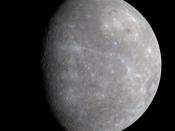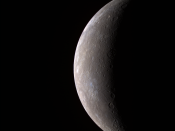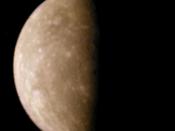In Greek mythology there is a god named Hermes, messenger of the gods, he travels from here and there in such great speeds, helping the gods deliver there guidance and wisdom to all those who need it, his alias was Mercury. This is also the name of the first planet from the sun. It is said that Mercury, the planet, received its name from the quick speed that it travels around the sun, like the messenger. Mercury also has a alias of its own, the Greeks gave it two names, Apollo as a morning star, and Hermes (or Mercury) as an evening star, because it as seen at both times, and some people thought that it was two different stars, although the Greeks were well aware that it was the same planet.
Mercury is one third of the Earth's size, and the smallest of the all nine planets except Pluto.
Mercury is also the closest planet to the Sun, this would automatically put the thought in your head that it would be extremely hot, in which case you would partly be right. Not only can Mercury reach temperatures of 430ðC (806ðF), temperatures estimated hot enough to melt lead, but in a single day its temperatures can plummet to temperatures of -180ðC (-292ðF), almost cold enough to liquefy air. These drastic temperature changes are due to the fact that Mercury has a very thin helium-sodium atmosphere, without a strong and durable atmosphere Mercury has no protection from the impact of meteors which causes the eroding craters on its surface, similar to the moons. Scientist also have detected a magnetic field similar to the earth's but not quite as strong, scientists' theory on the field is the possibility of an iron core. The average revolution period of Mercury is 87.9 earth days...


